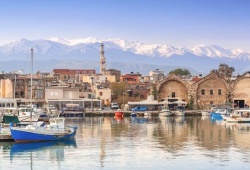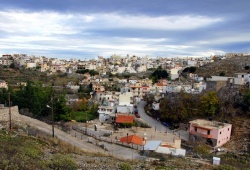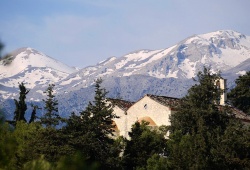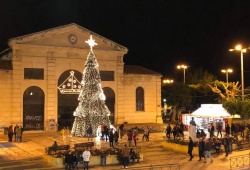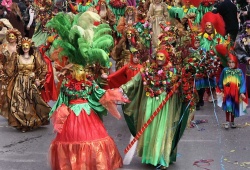Why you should visit Crete in Winter
Crete, the largest Greek island, is a popular tourist destination known for its stunning beaches, ancient ruins, and vibrant culture. While summer is the peak season for visitors, there are numerous reasons why you should consider exploring Crete during the winter months. From mild weather and fewer crowds to unique cultural experiences and breathtaking landscapes, a winter visit to Crete offers a different perspective on this enchanting island.
1. Mild Weather:
Contrary to what one might expect, winter in Crete is characterized by mild temperatures and pleasant weather conditions. With average temperatures ranging from 10 to 15 degrees Celsius (50 to 59 degrees Fahrenheit), the island offers a comfortable climate for outdoor activities. While the sea might be too chilly for swimming, the absence of scorching heat allows for enjoyable hikes, walks along the coast, and exploration of historical sites without the discomfort of excessive sweating or sunburn.
2. Authentic Cultural Experiences:
Visiting Crete in winter offers a unique opportunity to immerse yourself in the island's authentic culture. With fewer tourists around, you can engage more deeply with the local community and experience traditional Cretan life firsthand. The locals are known for their warm hospitality and genuine friendliness, making it easier to connect with them and learn about their customs and traditions.
During the winter months, many traditional festivals take place across the island. These celebrations offer a glimpse into Cretan folklore, music, and dance. The most famous of these festivals is the Carnival of Rethymno, where locals dress in colorful costumes and parade through the streets, accompanied by traditional music and dancing. Attending such events allows you to witness the vibrant cultural heritage of Crete and create lasting memories.
3. Tranquility and Fewer Crowds:
One of the main advantages of visiting Crete in winter is the tranquility and peacefulness that can be enjoyed. With fewer tourists, you can explore popular attractions without the crowds and long queues that are common during the summer months. This allows for a more relaxed and intimate experience, enabling you to fully appreciate the beauty of the island's landmarks.
The serene atmosphere also extends to the island's beaches. While swimming might not be ideal during winter, the stunning coastline remains a sight to behold. Picture yourself strolling along the deserted shores, listening to the sound of crashing waves and feeling a sense of tranquility that is hard to find in the bustling summer months. The solitude and calmness of Crete in winter offer a unique opportunity for introspection and rejuvenation.
4. Lower Prices and Deals:
Another significant advantage of visiting Crete in winter is the potential for cost savings. As the demand for accommodation and flights decreases during this season, prices tend to be more affordable compared to the peak summer months. This means you can enjoy high-quality accommodations, delicious local cuisine, and various activities at a fraction of the cost.
Between November and March, there are no direct flights from Europe to the island. However, the island still has excellent access to major European capitals. Numerous airlines provide flights to both Heraklion and Chania, primarily via Athens or Thessaloniki.
5. Winter Outdoor Activities:
There are plenty of places to see, like as the Heraklion Archaeological Museum, Knossos Palace and Festos. The greatest time to visit Rethymnon is in the winter, when the little town is much more enjoyable without visitors swarming the top attractions. Highlights include visiting the Venetian Harbor and taking a stroll around the Fortezza. Most of the museums on the island are still available for you to visit.
Hiking is a fantastic way to see Crete's stunning natural surroundings, even if the island is warmer than other regions of Greece. Although Samaria Gorge is closed in the winter, you may still trek to Imbros Gorge, which is a shorter distance. It is fairly simple and quick to reach to Imbros, as the settlement of Omalos is only 1 km away from the entrance. The entire walk takes around three hours.
Situated on the slopes of Psiloritis mountain, the highest peak in Crete, Zoniana and Anogia are two authentic Cretan villages that are well worth a visit. They are around 40 kilometers from Heraklion town. The villages take on a unique quality in the winter, when smoke rises from the many chimneys and the little streets are blanketed with snow.
To experience the atmosphere of Crete, visit a traditional kafeneion or raki bar in most villages on the island. Raki and little dishes of food known as mezedes will be served to you. At the end your will enjoy a Cretan sweet delight.
Conclusion
While Crete is undoubtedly a popular summer destination, visiting during the winter months offers a different perspective on this captivating island. Mild weather, authentic cultural experiences, tranquility, and cost savings are just a few of the reasons why a winter visit to Crete should be on your travel itinerary. So, pack your bags, explore the ancient ruins, hike through breathtaking landscapes, and immerse yourself in the warm hospitality of the Cretan people. You won't be disappointed by the wonders that await you in Crete during the winter season.



